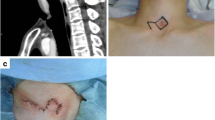Abstract
When a tracheostoma is no longer needed, the opening normally closes spontaneously after cannula removal, but some cases require tracheostoma closure. This procedure has been well described, but must be performed in such a way as to minimize its invasiveness and complications while securing a high closure rate. Our procedure for conducting tracheostoma closure technique involves the creation of two hinge flaps and one cover flap to close the tracheostomy opening. We reviewed the medical records of 23 patients (12 men, 11 women; mean age 60.0 SD19.7 years) who underwent tracheostoma closure technique between 2001 and 2019. Surgery was indicated for patients in whom closure had not occurred after conservative monitoring for ≥ 2 months following cannula removal. The surgical procedure began by raising two hinge flaps on either side of the tracheostomy opening, turning the skin surface to the luminal side to form the anterior tracheal wall. Rather than a single layer of skin, multiple skin layers were sutured together to prevent air leakage from between hinge flaps. A further cover flap was produced to cover the anterior tracheal wall, closing the tracheostomy opening. Postoperatively, the tracheal lumen was observed via fiberscopy. No stenosis of the tracheal lumen occurred in any patients, and the tracheocutaneous fistula was successfully closed in all cases. Tracheostoma closure technique using hinge flaps to reconstruct the anterior tracheal wall and a cover flap as a skin flap to cover the skin defect appears useful for patients with failure of spontaneous tracheocutaneous fistula closure.

Similar content being viewed by others
References
White KA, Smitheringale AJ (1995) Treatment of tracheocutaneous fistula in children. J Surg Oncol 59:196–198
Tomioka T, Fuke T, Miyamura T et al (2008) The time course after tracheotomy –Could the tracheal stoma be closed certainly?-. Pract Otorhinolaryngol 11:871–876
Kulber H, Passy V (1972) Tracheostomy closure and scar revisions. Arch Otolaryngol 96:22–26
Nakamura K, Yamaguchi H, Horiguchi S et al (2001) Surgical techniques for closure of tracheostoma. J Jpn Bronchoesophagol Soc 52:331–335
Masaaki H, Norio S, Shinpei I et al (2015) Closure of tracheo-cutaneous fistula. J Jpn Bronchoesophagol Soc 66:7–12
Jacobs JR (1995) Bipedicle delayed flap of persistent radiated tracheocutaneous fistulas. J Surg Oncol 59:196–198
Lee UJ, Goh EK, Wang SG et al (2002) Closure of large tracheocutaneous fistula using turn-over hinge flap and V-Y advancement flap. J Laryngol Otol 116:627–629
Krizek TJ, Kirchner JA (1972) Tracheal reconstruction with an autogenous mucochondrial graft. Plast Reconstr Surg 50:123–130
Yoshimura Y, Nakajima T (1990) Tracheoplasty with palatal mucoperiosteal graft. Plast Reconstr Surg 86:558–562
Taffel M (1940) The repair of tracheal and bronchial defects with free fascia grafts. Surgery 8:56–62
Tatekawa Y, Yamanaka H, Hasegawa T (2013) Closure of a tracheocutaneous fistula by two hinged turnover skin flaps and a muscle flap. Int J Surg Case Rep 4:170–174
Kamiyoshihara M, Nagashima T, Takeyoshi I (2011) A novel technique for closing a tracheocutaneous fistula using a hinged skin flap. Surg Today 41:1166–1168
Funding
None.
Author information
Authors and Affiliations
Contributions
All authors contributed to the design and implementation of the research and to the writing of the manuscript. All authors read and approved the final manuscript.
Corresponding author
Ethics declarations
Conflict of interest
None.
Ethical Approval
This study was conducted with the approval of the Nihon University Itabashi Hospital Ethics Committee (approval number RK-200310–5).
Additional information
Publisher's Note
Springer Nature remains neutral with regard to jurisdictional claims in published maps and institutional affiliations.
Rights and permissions
Springer Nature or its licensor (e.g. a society or other partner) holds exclusive rights to this article under a publishing agreement with the author(s) or other rightsholder(s); author self-archiving of the accepted manuscript version of this article is solely governed by the terms of such publishing agreement and applicable law.
About this article
Cite this article
Miura, R., Nakamura, K., Matsuzaki, H. et al. Tracheostoma Closure Technique Using Three Local Flaps. Indian J Otolaryngol Head Neck Surg 75, 2798–2801 (2023). https://doi.org/10.1007/s12070-023-03855-6
Received:
Accepted:
Published:
Issue Date:
DOI: https://doi.org/10.1007/s12070-023-03855-6




